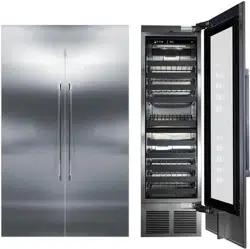Loading ...
Loading ...
Loading ...

PERLICK RESIDENTIAL COLUMN REFRIGERATION USE & CARE GUIDE
14 | perlick.com/residential
SURFACE CARE AND CLEANING
STAINLESS STEEL CARE AND CLEANING
Stainless steel is a “passive” metal because it contains other
metals like Chromium, Nickel and Manganese that stablize the
atoms. Chromium provides an invisible lm that covers the steel
surface, acng as a shield agent against corrosion. As long as
the lm is intact and not contaminated, the metal is passive and
stainless. If the passive lm of stainless steel has been broken,
the surface can start to corrode or rust.
Three materials or processes can break down stainless steel’s
passive layer, allowing corrosion to occur.
▪ Mechanical Abrasion This refers to items that will scratch
stainless steel surfaces. Steed pads, wire brushes and
scrapers are prime examples.
▪ Water Water that comes out of the faucet in varying
degrees of hardness. Hard water may leave spots. When
allowed to sit, these deposits will break down the passive
Chromium layer and rust stainless steel. Other deposits
from food preparaon must be promptly removed with an
appropriate cleaning agent.
▪ Chlorides Chlorides are found everywhere. They are
in water, food and table salt. Household and industrial
cleaners are the worst oenders.
Prevenng Stainless Steel Rust
Use non-abrasive tools to clean stainless steel surfaces. So
cloths and plasc scouring pads will not harm the steel’s passive
layer.
Clean with polish lines. Some stainless steels have visible
polishing lines or “grain”. When visible lines are present, always
scrub in a moon parallel to the lines. When the grain cannot
be seen, polish in a consistent straight paern - not in a circular
moon.
Use alkaline, alkaline chlorinated or non-chloride containing
cleaners. While many tradional cleaners are loaded with
chlorides, the industry is providing an ever-increasing choice of
non-chloride cleaners. If you are not sure of chloride content
in the cleaner being used, contact your cleaner supplier. If you
present cleaner contains chloride, ask your supplier for an
alternave. Avoid cleaners containing quaternary salt; it also
can aack stainless steel and cause ping and/or rusng. Clean
frequently to avoid build-up of hard, stubborn stains.
Stainless Steel Exterior Door Cleaning
Keep exterior stainless steel surface prisne by wiping the
door with a damp microber cloth, followed by a dry polishing
chamois. Always follow the grain direcon when cleaning.
SLATE METALLIC SURFACE CARE AND CLEANING
Perlick’s slate metallic surface is nished with powder coat.
When properly cared for, powder coang provides a durable,
uniform nish that is resistant to scung, scratching and
staining.
The following surfaces are slate metallic (see yellow outlines
below for locaons):
▪ Refrigerator Models Drawers, Tip Out Bin, Door Bins
▪ Freezer Models Drawer Bins, Door Bins
▪ Wine Models Wine Shelf Fronts
To clean the slate metallic surface:
1. Carefully remove any loose debris with a damp sponge.
2. Use a so cloth and a mild household detergent soluon to
remove deposits.
3. Wipe area with so cloth and clean water. Dry thoroughly.
Loading ...
Loading ...
Loading ...
